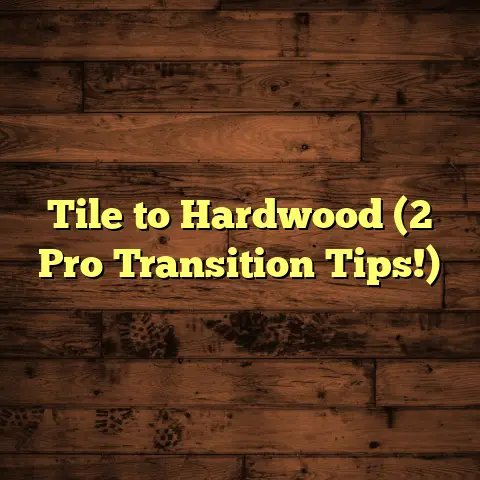Fix Uneven Floors In Old House? (2 Hidden Hazards!)
(2 Hidden Hazards!)
Have you ever walked into an old house and felt that subtle dip under your feet? Or maybe you noticed a slight slope that made you feel like you were on a ship? What if that seemingly minor issue could be hiding something far more serious than just a cosmetic flaw?
Uneven floors in old homes aren’t just about aesthetics; they can be a sign of underlying structural problems, potential safety hazards, and even health risks. In this article, I’ll walk you through the common causes, how to spot them, the hidden dangers they pose, and what you can do to fix them. Let’s dive in!
Section 1: Understanding the Causes of
Uneven Floors
As a flooring contractor with years of experience, I’ve seen my fair share of uneven floors in old houses. Trust me, it’s rarely just bad luck. Here are some of the most common culprits:
-
Natural Settling Over Time:
Old houses, like old bones, settle over time. The soil beneath the foundation compacts, causing the house to shift. This is normal, but uneven settling can lead to significant floor problems. Imagine a house built on soil that’s not uniformly dense. Over decades, the denser areas will support the house better, while the less dense areas will compress, causing the foundation – and the floors above – to sink unevenly.
-
Foundation Issues:
The foundation is the backbone of your house. Cracks, shifts, or sinking in the foundation directly impact the floors above. I once worked on a house where a section of the foundation had crumbled due to poor drainage. The resulting sag in the floor was so pronounced, you could roll a marble from one side of the room to the other!
-
Moisture and Water Damage:
Water is enemy number one for old houses. Leaky roofs, poor drainage, or burst pipes can wreak havoc on the wooden subfloor and support beams. Wood expands and contracts with moisture, leading to warping, rot, and ultimately, uneven floors. I’ve seen cases where years of undetected leaks caused the subfloor to literally disintegrate, leaving a soft, spongy area under the carpet.
-
Pest Infestations (Termites, Rodents):
Don’t underestimate the destructive power of tiny creatures! Termites and rodents can chew through wooden support structures, weakening them and causing floors to sag. Termites, in particular, are notorious for hollowing out wooden beams from the inside, leaving little visible damage until it’s too late.
-
Poor Construction Practices:
Sometimes, the problem stems from the original construction. Old houses weren’t always built to modern standards. Improperly spaced joists, inadequate support beams, or using subpar materials can all contribute to uneven floors down the line.
Section 2: Identifying the Signs of
Uneven Floors
Okay, so how do you know if you have uneven floors? Here are some telltale signs to watch out for:
-
Visible Slopes or Dips in the Flooring:
This is the most obvious sign. Stand in the room and visually scan the floor. Do you notice any areas that appear to slope downward or have a noticeable dip? Sometimes, it’s subtle, but if you pay close attention, you’ll see it.
-
Gaps Between the Floor and Walls or Baseboards:
As the floor settles unevenly, it can pull away from the walls, creating gaps. These gaps are often most noticeable along the baseboards.
-
Doors That Stick or Don’t Close Properly:
Uneven floors can throw the entire house out of alignment, causing doors to stick, swing open or closed on their own, or not latch properly. This is because the door frame is no longer square.
-
Cracks in the Walls or Ceiling:
While cracks can have many causes, uneven floors can exacerbate or even cause cracks in the walls and ceiling. These cracks are often diagonal and appear near door frames or windows.
-
The “Marble Test”:
This is a simple but effective way to check for unevenness. Place a marble (or a small ball) on the floor and see if it rolls. If it does, you likely have a slope.
-
Water Pooling:
After cleaning the floor, do you notice water pooling in certain areas? This is another sign of a low spot.
-
Unusual Noises:
Do your floors creak or groan excessively when you walk on them? This could indicate that the subfloor is shifting due to uneven support.
How to Perform a Basic Inspection:
-
Visual Inspection: Start by simply looking at the floors, walls, and ceiling. Look for the signs mentioned above.
-
Use a Level: Place a long level (at least 4 feet) on the floor in different areas. Note any significant deviations from level.
-
Check the Foundation: If possible, inspect the foundation for cracks, signs of water damage, or shifting.
-
Bounce Test: Gently bounce on the floor in different areas. Does it feel solid, or does it have excessive give?
Section 3: The Hidden Hazards of
Uneven Floors
Uneven floors aren’t just an eyesore; they can pose serious risks to your home and your health. Here are two major hidden hazards:
-
Structural Risks:
Uneven floors can be a symptom of deeper structural problems. If the foundation is compromised, the floor joists are rotting, or the support beams are failing, the entire structural integrity of your house could be at risk. This can lead to:
- Wall Collapse: Severely uneven floors can put stress on the walls, potentially leading to cracks and, in extreme cases, collapse.
- Roof Problems: The shifting foundation can affect the roof, causing leaks, sagging, and other issues.
- Complete Structural Failure: In the worst-case scenario, a severely compromised structure could become unsafe to live in.
According to the American Society of Civil Engineers (ASCE), the average age of infrastructure in the U.S. is increasing, and many homes are facing structural challenges due to aging and lack of maintenance. Uneven floors can be an early warning sign of these underlying issues.
-
Health Risks:
Uneven floors can also create several health hazards:
- Trips and Falls: This is the most obvious risk. Uneven surfaces increase the risk of tripping and falling, especially for children, the elderly, and people with mobility issues. The Centers for Disease Control and Prevention (CDC) reports that falls are a leading cause of injury and death in older adults.
- Mold Growth: Uneven floors caused by water damage can create an ideal environment for mold growth. Mold can trigger allergies, asthma, and other respiratory problems.
- Strain and Fatigue: Walking on uneven surfaces can put extra strain on your muscles and joints, leading to fatigue and discomfort.
- Psychological Stress: Living in a house with uneven floors can be stressful and anxiety-inducing. The constant awareness of the unevenness can be mentally draining.
Section 4: DIY Solutions for Fixing
Uneven Floors
If you’re a handy homeowner and the unevenness is relatively minor, you might be able to tackle the problem yourself. Here are a few DIY solutions:
-
Leveling Compounds for Minor Dips:
For small dips or imperfections (less than 1/4 inch), leveling compounds can work wonders.
- Prepare the Surface: Clean the floor thoroughly, removing any debris, dust, or loose particles. You might need to sand the area to create a better bonding surface.
- Prime the Surface: Apply a primer specifically designed for leveling compounds. This helps the compound adhere properly.
- Mix the Compound: Follow the manufacturer’s instructions carefully to mix the leveling compound.
- Apply the Compound: Pour the compound onto the low spot and use a trowel or squeegee to spread it evenly.
- Let it Dry: Allow the compound to dry completely according to the manufacturer’s instructions.
- Sand if Necessary: Once dry, you may need to lightly sand the surface to smooth out any imperfections.
Tools and Materials: Leveling compound, primer, trowel, mixing bucket, sandpaper, safety glasses, dust mask.
Potential Costs: \$20 – \$50 for materials.
-
Shimming and Adjusting Joists for Moderate Issues:
If the unevenness is more significant (1/4 inch to 1 inch), you might need to shim the floor joists from below.
- Access the Joists: You’ll need access to the floor joists, usually from a basement or crawl space.
- Locate the Low Spot: Use a level to identify the joist(s) that are causing the low spot.
- Shim the Joist: Cut shims (thin pieces of wood) to the appropriate thickness and insert them between the joist and the subfloor.
- Secure the Shims: Use construction adhesive or screws to secure the shims in place.
- Check for Level: Continuously check the floor above with a level to ensure you’re raising it to the correct height.
Tools and Materials: Shims, level, construction adhesive, screws, drill, safety glasses.
Potential Costs: \$30 – \$70 for materials.
-
When and How to Use Floor Jacks for Major Adjustments:
For major sagging or settling (over 1 inch), you might need to use floor jacks to temporarily lift the floor. This is a more complex and potentially dangerous project, so proceed with caution.
- Assess the Situation: Carefully assess the situation to determine the extent of the problem and the number of jacks needed.
- Position the Jacks: Place the jacks on a solid foundation (concrete slab or compacted soil) directly beneath the affected joists.
- Lift Slowly and Gradually: Slowly and gradually raise the jacks, lifting the floor in small increments.
- Monitor for Cracks: Watch for cracks in the walls or ceiling as you lift. If you see any, stop immediately.
- Install Permanent Support: Once the floor is level, install permanent support columns or beams to support the joists.
- Remove the Jacks: Carefully remove the floor jacks.
Tools and Materials: Floor jacks, support columns or beams, level, safety glasses, work gloves.
Potential Costs: \$100 – \$500 for materials and rental equipment.
Important Considerations:
- Safety First: Always wear safety glasses and work gloves when working on these projects.
- Proper Ventilation: Ensure proper ventilation when working with leveling compounds or adhesives.
- Load-Bearing Walls: Be extremely careful when working near load-bearing walls. Consult with a professional if you’re unsure.
Section 5: When to Call a Professional
While DIY solutions can be effective for minor issues, there are times when it’s best to call in the pros. Here are some scenarios where professional help is advisable:
-
Significant Structural Damage:
If you suspect significant structural damage to the foundation, joists, or support beams, it’s crucial to consult with a structural engineer and a qualified contractor. They can assess the damage and recommend the appropriate repairs.
-
Extensive Foundation Issues:
Major foundation problems, such as sinking, cracking, or shifting, require professional attention. Foundation repair can be complex and expensive, but it’s essential to protect the structural integrity of your home.
-
Complex Repairs That Require Specialized Knowledge or Equipment:
If the repairs involve significant modifications to the structure, working with electrical wiring or plumbing, or using specialized equipment like hydraulic jacks, it’s best left to the professionals.
How to Choose the Right Contractor:
- Get Multiple Quotes: Get quotes from at least three different contractors.
- Check References: Ask for references and follow up with previous clients.
- Verify Licensing and Insurance: Make sure the contractor is licensed and insured.
- Read Reviews: Check online reviews on sites like Yelp or Google.
- Get a Written Contract: Make sure the contract clearly outlines the scope of work, the materials to be used, the timeline, and the payment schedule.
Questions to Ask During Consultations:
- What is the root cause of the uneven floors?
- What is your proposed solution?
- What is the estimated cost and timeline?
- What permits are required?
- Do you offer a warranty on your work?
- What is your experience with similar projects?
Section 6: Preventative Measures for
Maintaining Level Floors
Prevention is always better than cure. Here are some steps you can take to maintain your floors and prevent future issues:
-
Regular Inspections and Maintenance of the Foundation:
Inspect your foundation regularly for cracks, signs of water damage, or shifting. Address any issues promptly to prevent them from worsening.
-
Proper Drainage Systems to Avoid Water Damage:
Ensure that your gutters and downspouts are clean and functioning properly to direct water away from the foundation. Consider installing French drains or other drainage systems to improve drainage around your home.
-
Addressing Pest Control Measures Proactively:
Take steps to prevent pest infestations by sealing cracks and crevices in your foundation, keeping your yard clean and free of debris, and scheduling regular pest control treatments.
-
Maintain Proper Ventilation:
Ensure proper ventilation in your basement or crawl space to prevent moisture buildup, which can lead to wood rot and uneven floors.
-
Monitor Humidity Levels:
Use a dehumidifier to control humidity levels in your home, especially in damp basements or crawl spaces.
Conclusion
Uneven floors in old houses are more than just a cosmetic issue. They can be a sign of underlying structural problems, potential safety hazards, and even health risks. By understanding the causes, identifying the signs, and taking appropriate action, you can protect your home and your family.
Whether you choose to tackle the repairs yourself or consult with a professional, the key is to address the problem promptly and effectively. Don’t let those uneven floors become a hidden hazard lurking beneath your feet. Take action today to ensure a safe, stable, and comfortable home for years to come.





